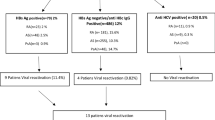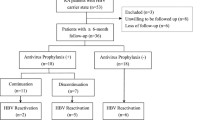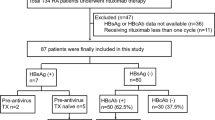Abstract
Clinical guidelines regarding anti-viral prophylaxis for HBV surface antigen (HBsAg) carriers starting anti-TNFα agents are not yet fully established, even in endemic regions of HBV infection. We retrospectively collected the clinical data of 52 HBsAg carriers with rheumatoid arthritis (RA) or ankylosing spondylitis (AS) that had been administered anti-TNFα treatment at seven medical centers in South Korea. Periodic data of liver function tests and serum HBV DNA were both utilized to assess HBV reactivation. The YMDD motif mutation of HBV DNA polymerase was tested in lamivudine-treated patients with elevated HBV DNA. Three of the 52 patients were excluded from the analysis. Of the 49 analyzed patients, 20 patients received anti-viral prophylaxis (15 lamivudine, five entecavir) with anti-TNFα treatment. The remaining 29 patients were treated with anti-viral agents if needed at the discretion of the clinician and did not receive prophylaxis. Of the 29 patients who did not receive primary prophylaxis, two (6.9%) developed viral reactivation within a year of anti-TNFα treatment. In the prophylaxis group, one patient developed viral reactivation at week 64 of anti-TNFα therapy attributed to YMDD mutation caused by lamivudine. Patients with HBV reactivation all responded well to anti-viral therapy. In summary, anti-viral prophylaxis helped preventing HBV reactivation in HBsAg carriers with RA or AS starting anti-TNFα, yet mutation in the YMDD motif of HBV DNA polymerase could be detrimental to some patients under long-term lamivudine prophylaxis.

Similar content being viewed by others
References
Raychaudhuri SP, Nguyen CT, Raychaudhuri SK et al (2009) Incidence and nature of infectious disease in patients treated with anti-TNF agents. Autoimmun Rev 9:67–81
Keane J, Gershon S, Wise RP et al (2001) Tuberculosis associated with infliximab, a tumor necrosis factor alpha-neutralizing agent. N Engl J Med 345:1098–1104
Gupta S, Govindarajan S, Fong TL et al (1990) Spontaneous reactivation in chronic hepatitis B: patterns and natural history. J Clin Gastroenterol 12:562–568
Perrillo RP (2001) Acute flares in chronic hepatitis B: the natural and unnatural history of an immunologically mediated liver disease. Gastroenterology 120:1009–1022
Esteve M, Saro C, Gonzalez-Huix F et al (2004) Chronic hepatitis B reactivation following infliximab therapy in Crohn’s disease patients: need for primary prophylaxis. Gut 53:1363–1365
Sakellariou GT, Chatzigiannis I (2007) Long-term anti-TNFalpha therapy for ankylosing spondylitis in two patients with chronic HBV infection. Clin Rheumatol 26:950–952
Carroll MB, Bond MI (2008) Use of tumor necrosis factor-alpha inhibitors in patients with chronic hepatitis B infection. Semin Arthritis Rheum 38:208–217
Ojiro K, Naganuma M, Ebinuma H et al (2008) Reactivation of hepatitis B in a patient with Crohn’s disease treated using infliximab. J Gastroenterol 43:397–401
Chung SJ, Kim JK, Park MC et al (2009) Reactivation of hepatitis B viral infection in inactive HBsAg carriers following anti-tumor necrosis factor-alpha therapy. J Rheumatol 36:2416–2420
Kim YJ, Bae SC, Sung YK et al (2010) Possible reactivation of potential hepatitis B virus occult infection by tumor necrosis factor-alpha blocker in the treatment of rheumatic diseases. J Rheumatol 37:346–350
Lan JL, Chen YM, Hsieh TY et al (2011) Kinetics of viral loads and risk of hepatitis B virus reactivation in hepatitis B core antibody-positive rheumatoid arthritis patients undergoing anti-tumour necrosis factor alpha therapy. Ann Rheum Dis 70:1719–1725
Tamori A, Koike T, Goto H et al (2011) Prospective study of reactivation of hepatitis B virus in patients with rheumatoid arthritis who received immunosuppressive therapy: evaluation of both HBsAg-positive and HBsAg-negative cohorts. J Gastroenterol 46:556–564
Ganem D, Prince AM (2004) Hepatitis B virus infection—natural history and clinical consequences. N Engl J Med 350:1118–1129
Guidotti LG, Ishikawa T, Hobbs MV et al (1996) Intracellular inactivation of the hepatitis B virus by cytotoxic T lymphocytes. Immunity 4:25–36
Guidotti LG, Ando K, Hobbs MV et al (1994) Cytotoxic T lymphocytes inhibit hepatitis B virus gene expression by a noncytolytic mechanism in transgenic mice. Proc Natl Acad Sci U S A 91:3764–3768
Arnett FC, Edworthy SM, Bloch DA et al (1988) The American Rheumatism Association 1987 revised criteria for the classification of rheumatoid arthritis. Arthritis Rheum 31:315–324
van der Linden S, Valkenburg HA, Cats A (1984) Evaluation of diagnostic criteria for ankylosing spondylitis. A proposal for modification of the New York criteria. Arthritis Rheum 27:361–368
Hoofnagle JH (2009) Reactivation of hepatitis B. Hepatology 49:S156–S165
Korea Centers for Disease Control and Prevention (2007) The Fourth Korea National Health and Nutrition Examination Survey (KNHANES III), pp 70–71
Kuwabara H, Fukuda A, Tsuda Yet al (2010) Precore mutant hepatitis B virus-associated fulminant hepatitis during infliximab therapy for rheumatoid arthritis. Clin Rheumatol
Michel M, Duvoux C, Hezode C et al (2003) Fulminant hepatitis after infliximab in a patient with hepatitis B virus treated for an adult onset Still’s disease. J Rheumatol 30:1624–1625
Dienstag JL (2008) Hepatitis B virus infection. N Engl J Med 359:1486–1500
Vassilopoulos D, Apostolopoulou A, Hadziyannis E et al (2010) Long-term safety of anti-TNF treatment in patients with rheumatic diseases and chronic or resolved hepatitis B virus infection. Annals Rheum Dis 69:1352–1355
Colonno RJ, Rose R, Baldick CJ et al (2006) Entecavir resistance is rare in nucleoside naive patients with hepatitis B. Hepatology 44:1656–1665
Lok AS, McMahon BJ (2007) Chronic hepatitis B. Hepatology 45:507–539
Kim ES, Seoh YS, Lee KG et al (2008) Hepatitis B virus DNA level is a significant predictive factor for hepatitis B virus reactivation in inactive HBs antigen carriers. Korean J Hepatol 14:88
Liaw YF (1998) Hepatitis viruses under immunosuppressive agents. J Gastroenterol Hepatol 13:14–20
Nathan DM, Angus PW, Gibson PR (2006) Hepatitis B and C virus infections and anti-tumor necrosis factor-alpha therapy: guidelines for clinical approach. J Gastroenterol Hepatol 21:1366–1371
Acknowledgements
This study was supported by a grant of the Korea Healthcare Technology R&D Project, Ministry of Health and Welfare, South Korea (#A102065). All authors declare that they have no proprietary, commercial, or financial interests that could be construed to have inappropriately influenced this study.
Disclosures
None.
Author information
Authors and Affiliations
Corresponding author
Rights and permissions
About this article
Cite this article
Ryu, H.H., Lee, E.Y., Shin, K. et al. Hepatitis B virus reactivation in rheumatoid arthritis and ankylosing spondylitis patients treated with anti-TNFα agents: A retrospective analysis of 49 cases. Clin Rheumatol 31, 931–936 (2012). https://doi.org/10.1007/s10067-012-1960-1
Received:
Revised:
Accepted:
Published:
Issue Date:
DOI: https://doi.org/10.1007/s10067-012-1960-1




